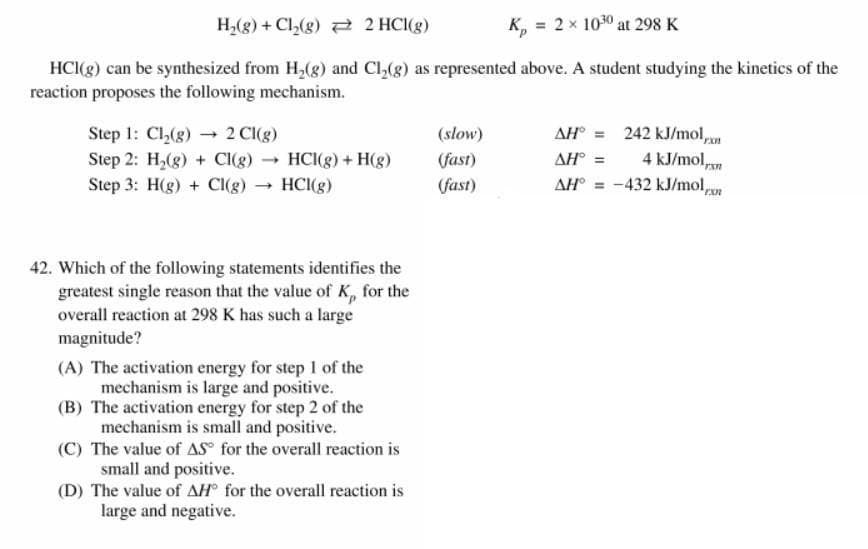HCI(g) can be synthesized from H,(g) and Cl,(g) as represented above. A student studying the kinetics of the reaction proposes the following mechanism. AH = 242 kJ/mol, AH = 4 kJ/mol, -432 kJ/mol, 2 Cl(g) (slow) Step 1: Cl,(g) Step 2: H,(g) + CI(g) HCI(g) + H(g) Step 3: H(g) + Cl(g) HCI(g) (fast) (fast) AH 42. Which of the following statements identifies the greatest single reason that the value of K, for the overall reaction at 298 K has such a large magnitude? (A) The activation energy for step I of the mechanism is large and positive. (B) The activation energy for step 2 of the mechanism is small and positive. (C) The value of AS for the overall reaction is small and positive. (D) The value of AH° for the overall reaction is large and negative.
HCI(g) can be synthesized from H,(g) and Cl,(g) as represented above. A student studying the kinetics of the reaction proposes the following mechanism. AH = 242 kJ/mol, AH = 4 kJ/mol, -432 kJ/mol, 2 Cl(g) (slow) Step 1: Cl,(g) Step 2: H,(g) + CI(g) HCI(g) + H(g) Step 3: H(g) + Cl(g) HCI(g) (fast) (fast) AH 42. Which of the following statements identifies the greatest single reason that the value of K, for the overall reaction at 298 K has such a large magnitude? (A) The activation energy for step I of the mechanism is large and positive. (B) The activation energy for step 2 of the mechanism is small and positive. (C) The value of AS for the overall reaction is small and positive. (D) The value of AH° for the overall reaction is large and negative.
Chemistry & Chemical Reactivity
9th Edition
ISBN:9781133949640
Author:John C. Kotz, Paul M. Treichel, John Townsend, David Treichel
Publisher:John C. Kotz, Paul M. Treichel, John Townsend, David Treichel
Chapter14: Chemical Kinetics: The Rates Of Chemical Reactions
Section: Chapter Questions
Problem 84IL
Related questions
Question

Transcribed Image Text:H,(g) + Cl,(g) 2 HCI(g)
K, = 2 x 1030 at 298 K
HCI(g) can be synthesized from H,(g) and Cl,(g) as represented above. A student studying the kinetics of the
reaction proposes the following mechanism.
Step 1: Cl(g) 2 Cl(g)
Step 2: H,(g) + Cl(g) HCI(g) + H(g)
AH° = 242 kJ/mol,
(slow)
(fast)
(fast)
AH
4 kJ/mol,
-432 kJ/mol
%3D
Step 3: H(g) + CI(g)
HCI(g)
AH° =
42. Which of the following statements identifies the
greatest single reason that the value of K, for the
overall reaction at 298 K has such a large
magnitude?
(A) The activation energy for step I of the
mechanism is large and positive.
(B) The activation energy for step 2 of the
mechanism is small and positive.
(C) The value of AS for the overall reaction is
small and positive.
(D) The value of AH° for the overall reaction is
large and negative.
Expert Solution
This question has been solved!
Explore an expertly crafted, step-by-step solution for a thorough understanding of key concepts.
This is a popular solution!
Trending now
This is a popular solution!
Step by step
Solved in 2 steps with 1 images

Knowledge Booster
Learn more about
Need a deep-dive on the concept behind this application? Look no further. Learn more about this topic, chemistry and related others by exploring similar questions and additional content below.Recommended textbooks for you

Chemistry & Chemical Reactivity
Chemistry
ISBN:
9781133949640
Author:
John C. Kotz, Paul M. Treichel, John Townsend, David Treichel
Publisher:
Cengage Learning

Chemistry & Chemical Reactivity
Chemistry
ISBN:
9781337399074
Author:
John C. Kotz, Paul M. Treichel, John Townsend, David Treichel
Publisher:
Cengage Learning

Physical Chemistry
Chemistry
ISBN:
9781133958437
Author:
Ball, David W. (david Warren), BAER, Tomas
Publisher:
Wadsworth Cengage Learning,

Chemistry & Chemical Reactivity
Chemistry
ISBN:
9781133949640
Author:
John C. Kotz, Paul M. Treichel, John Townsend, David Treichel
Publisher:
Cengage Learning

Chemistry & Chemical Reactivity
Chemistry
ISBN:
9781337399074
Author:
John C. Kotz, Paul M. Treichel, John Townsend, David Treichel
Publisher:
Cengage Learning

Physical Chemistry
Chemistry
ISBN:
9781133958437
Author:
Ball, David W. (david Warren), BAER, Tomas
Publisher:
Wadsworth Cengage Learning,

Chemistry by OpenStax (2015-05-04)
Chemistry
ISBN:
9781938168390
Author:
Klaus Theopold, Richard H Langley, Paul Flowers, William R. Robinson, Mark Blaser
Publisher:
OpenStax

Chemistry for Engineering Students
Chemistry
ISBN:
9781337398909
Author:
Lawrence S. Brown, Tom Holme
Publisher:
Cengage Learning

Chemistry
Chemistry
ISBN:
9781305957404
Author:
Steven S. Zumdahl, Susan A. Zumdahl, Donald J. DeCoste
Publisher:
Cengage Learning